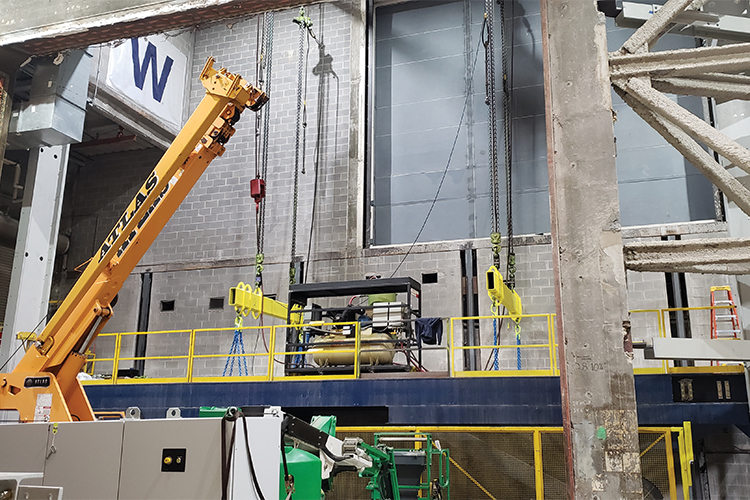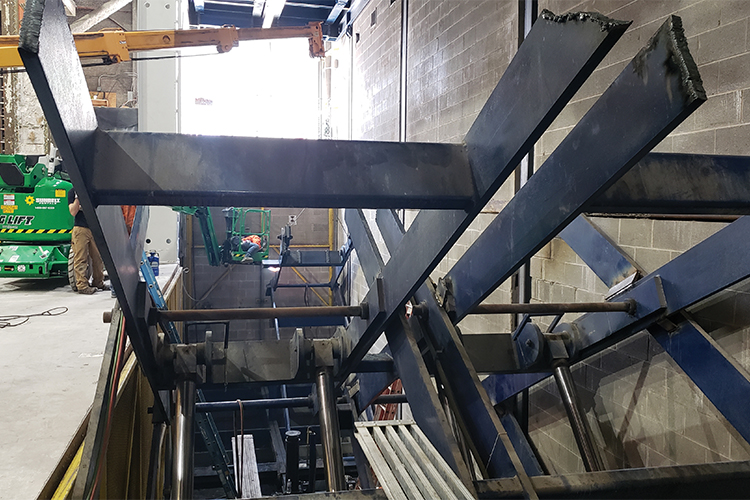August 25, 2022
Taking Lyric to the next level
When an 18-wheel semi truck carrying scenery for a Lyric Opera of Chicago production pulls up at the loading dock on Washington Street, the northern border of the company’s building, its journey isn’t quite finished. First it will make a right turn onto Wacker Drive and stop, more or less in front of the box office. There, the large over-the road sleeper cab, ubiquitous on the nation’s highways, will be replaced by what is known as a “city cab,” several feet shorter than the original. The truck then completes a circuit of the block, crossing the river twice more and pulling up this time on the far side of Washington, and backing its unusual cargo through the enormous door.
Though it will likely have already traveled quite a distance — scenery for Lyric’s upcoming Fiddler on the Roof, for instance, sailed across the Atlantic from a German port to a New York shipyard, boarded a train to Henry, Illinois (a little north of Peoria), and then was trucked to the Loop — the container still has about eight feet to go. That’s the measure from street level down to the Ardis Krainik Theatre’s backstage caverns. And that, for almost three decades now, has been the most perilous part of the trip. Things changed over the summer, with the installation of the company’s new, custom-built truck lift, a state-of-the-art equipment elevator with a capacity to raise and lower nearly 150,000 pounds. The machine should ably serve Lyric’s needs for years to come — an investment mostly invisible to the audience, but absolutely essential for almost everything that takes place on the stage. The new gear resembles large-scale, mechanized Legos and, in truth, it isn’t much to look at. Still, in the eyes of the dozens of backstage individuals who help make the curtains rise on time, it is a true thing of beauty.

During the complex installation of the new lift, the 58,000-pound platform was suspended by chains. The truck entrance on Washington Street is at left, under the “W” banner.
Lyric owns about 450 shipping containers, each 40 feet long by 8 feet high, and typically the company houses around 70 different shows. Stacked three-high, the metal behemoths live on a lot at 95th and Halsted, where Lyric also keeps its own crane and its dozen truck chassis. From the outside, the boxes look like any others. Inside, of course, they hold splendid elements of the world’s greatest art form. The movement of these objects in and out of the building, says Lyric Vice President and Technical Director Michael Smallwood, provides “the lifeblood of how we function on stage.”
Smallwood started at Lyric in 2007, right out of university. But he arrived with a wealth of experience. During his college years, alongside numerous freelance jobs at Chicago’s storefront theaters, he had stints with Chicago Shakespeare Theater, The Hypocrites, and Steppenwolf. “I would make sure all my classes were finished by noon,” he says, “so I could go to work.”
On “day one” at Lyric, he realized that the company’s hydraulic scissor lift, installed in the early 90s during what is known around the company as “The Renovation,” would need to be replaced. Along with the routine wear and-tear on a mechanism involved in every production, a hydraulic scissor lift is sensitive to other indignities such as temperature fluctuations and the variable weights of its load. The platform carrying containers and scenery would sometimes tilt precipitously, and the wall alongside the route bears numerous scratches as a result. Over time, and especially in the past few years, it was not uncommon for Smallwood and his team to be waiting hours, sometimes in the middle of the night, for emergency repairs. “I wouldn’t say that happened every day, but it happened a couple times a week,” he says. “And sometimes it cost us time and money and sometimes it didn’t.”
In May, immediately after the Joffrey Ballet’s final in-residence performance of its season, the old truck lift performed its last duty, lowering its gleaming replacement down to the backstage work area. Its 180,000 pounds of steel were then dismantled, and placed into dumpsters sitting right onstage, leaving the building in 20,000-pound increments, over a brisk two-week period.

The company’s old scissor lift. In all, nearly 180,000 pounds of steel were removed.
Installation of the new machine had been substantially delayed by the pandemic, but proceeded with some urgency this past summer. The new lift system was built by Tait, a global manufacturing company headquartered in Lititz, Pennsylvania, renowned especially in the world of rock. (When the band Coldplay, for instance, has a show at Soldier Field, it deploys an enormous stage set built by Tait.) The new mechanism at Lyric is one of the largest lifts it has ever made. (Because it is not designed or rated to carry passengers, Smallwood prefers the term “material handling elevator” to describe it).
While the actual 63,000-pound, 58-foot long platform the containers sit on remains from the original, the remarkable mechanics lowering it from street to stage level, and up to the enormous rehearsal room 200, are brand new. Known as a serapid chain, the lift consists of seven cassettes, full of what look like enormous bicycle chains. As the links (each about the size of a loaf of bread) are pushed out of the cassettes, they connect to the ones before and after them, forming rigid vertical columns.
“Most trucks you see on the road are probably in the 70,000 pound range. Ours are usually only in the 20,000 to 30,000 pound range,” Smallwood says. Still, he had the new lift rated for an 80,000-pound load, the equivalent of about eight large elephants. “Sometimes when we do a Great Performances with PBS, they bring in a camera truck. It’s just full of electrical cable, camera cable, all the lighting cable, and it weighs like 65,000 pounds. So we have to have that capacity.”
All these ups and downs take place in a large rectangular shaft, open on two sides, whose base (something like a very deep swimming pool) once served as the orchestra pit for the Civic Theater. As the loads travel, they move parallel to what was once that house’s proscenium arch, under which The Glass Menagerie premiered. It is decidedly less glamorous in this space now, though arguably far more essential.
The new machine passed its 80,000-pound weight test on June 24, and the first actual load, Smallwood says, was “a container of Don Carlos from Frankfurt.” Despite the complexities and scale of the undertaking, it has all come in quite close to budget. Longtime Lyric supporters Mr. and Mrs. William C. Vance gave a substantial gift to get things started (and it may be fairly said that opera lovers who donate to something an audience will never see are true opera lovers indeed). The summer tech period began in earnest on July 5 — by opera standards, just in the nick of time — and since then there have been trucks in and out almost every day. Overall, Smallwood notes, the lift provides a gift anyone might welcome — “one less thing to worry about every day.”
